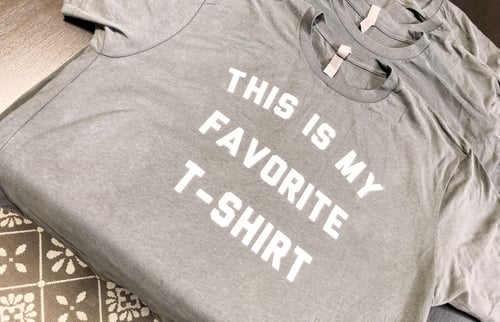PROMOTIONAL PRODUCT LINGO DEMYSTIFIED
“We’ll need vector art to complete the digitizing process. Do you want the logo tonal or tone-on-tone? The lead time will be 10 days after approval of the pre-production proof. Does that work for you?”
Huh?
You shouldn’t have to whip out an industry dictionary every time you order branded merchandise. Life is hard enough… bills, mismatched socks, an insane Netflix queue… without having to learn All The Lingo. So we’ve put together a handy list of commonly used terms to boost your confidence and help you sound like a pro when chatting about your next order.
GENERAL
Advertising speciality
A fancy term for promotional products pu
It refers to merchandise decorated with a logo or message, used to promote a brand (and create passionate fans).
(See also: swag)
Distributor
A person or company representing various promotional product factories
A good distributor takes your order and sees it through from start to finish. An awesome distributor (like Buzztag… *ahem*) brings the creative muscle. They are your greatest ally in evolving the connection with your crowd and creating items that make people happy.
Employee incentive program
Envy-inducing swag presented to employees for above-and-beyond work or goals met
Also called: recognition program
Fulfillment
An additional service some distributors (including Buzztag) offer that involves inventory management, warehousing, packaging and/or shipping items previously purchased
Leave-behind
A branded item you leave behind to help someone remember you
(It should be something they’ll want to hold on to… forever.)
POP (Point-of-Purchase)
Advertising materials, such as displays and cards, strategically placed to draw attention to a product
Promotional products
Distinctive items decorated with your logo or message (usually given away to promote a product, brand or event)
A few fun facts:
83% of people like receiving promotional products.
8 out of 10 people remember the brand advertised.
73% of people use a promotional product at least once a week.
Swag
Stuff We All Get
We also like to think of it as Stuff We All Give.
ART + LOGOS
4-color process (CMYK)
A printing process where a full-color image is separated into four different color values
Literally thousands of colors can be reproduced with just the four process ink colors: cyan (blue), magenta (red), yellow and black (CMYK).
CMYK is the standard method for printing full-color logos.
Digitize
Transforming an art file into a digital format
High-tech embroidery machines read your digitized file as a sewing pattern. It tells the machine where to sew, what type of embroidery stitch to use, color sequences and what your nickname was in high school. (Moose? Don’t worry, your secret is safe with us.)
Pantone/PMS
Pantone is a precise color scale used to match individual colors for printing. Each color has a coded number indicating instructions for mixing inks to achieve the hue.
PMS (Pantone Matching System) is a universal system of colors used to identify, match and communicate colors… similar to paint swatches. “What PMS color do you want to use?” is a common question in the promotional products world.
Vector graphics
These are files created by illustration software programs that use mathematical equations and geometric primitives… stay with us here… to create art that is clean, print-ready and infinitely scalable without a loss of quality. Other file types often become pixelated when enlarged, making them unusable.
Your logo in vector format can be reduced in size to fit a business card or scaled up to fit a billboard. One file rules them all. Cool, right?
Graphics file formats which are (or may be) Vector based:
AI - Adobe Illustrator (.ai)
PDF - Adobe (.pdf)
EPS - Encapsulated Postscript File (.eps)
CDR - Corel Draw
Most factories require vector art files. Practice this phrase and say it verbatim to your graphic designer:
“I need the logo in vector format with all fonts outlined.”
They’ll know what this means and it will save you a ton of time and energy.
DECORATION
Bleed
Not scary.
When a logo or image prints to the edge of the item
The artwork is designed to extend beyond the edges of the item so there
are no gaps in coverage during the printing process. Say you have an awesome full-color image you want to use for employee notebooks. Rather than adjusting the image to a small 2” x 2” imprint area, a full-bleed would allow you to take up the entire space of the cover.
Color match
Some factories only use standard (popular) imprint colors for their items. If you need an exact PMS color matched, the factory may charge a minimal fee to blend the color.
Debossing
A logo is pressed into a material such as paper, vinyl, leather or suede so it sits below the surface
Debossing can add subtle sophistication to your promo items.
Die cut
A process in which items like notepads, sticky notes, mouse pads, lapel pins, magnets and other items are custom cut to a desired shape
Embossing
Ever oohed and aahed while running your fingers over the raised lettering of an elegant invitation or business card? That’s embossing, a decorating technique that uses a concave and convex die to create a raised logo.
Embroidery
Decorating fabric or other materials using needle and thread
Forget about hunched over grandmothers hand-stitching your logo on a jacket. These days, high-tech machines embroider both simple and complex logos quickly and beautifully.
Heat press
Using a combination of heat and pressure, a design is transferred from specially-printed paper directly onto an item (kind of like the old transfers they used to do at carnivals… except these days it doesn’t crack and peel)
This option is useful for complicated artwork involving multiple colors and/or gradients as well as small quantity orders. Heat press can be a magical solution for when embroidery is too heavy or won’t work in a particular location. Keep it mind that heat press can be more expensive than screenprinting.
Imprint area
The maximum amount of space on a promotional product that will fit your logo or design
The size and/or location may vary depending on the item and decorating method. A pen with a ½” imprint area won’t fit your logo + name + address + phone number + url. We can help you figure out how to make best use of limited space.
Personalization
To decorate a product with a recipient's name or initials
Production time/Lead time
The amount of time needed to produce and ship an order
Depending on the factory, most products usually ship within 10 working days after proof approval. In a rush? We’ve got your back. Many of our factories offer 1-3-5 day production options.
If time is on your side, consider custom, one-of-a-kind showpieces produced overseas. We can create awesome hats on a 90-day turnaround (with ginormous cost savings).
Screenprinting/Silkscreening
Imprinting method in which a “stencil” is created for ink to be applied to the item
A multicolor design requires multiple screens.
Set-up charge/Screen charge/Plate charge
A factory charge that covers the cost of preparing your logo for production
This could include a screen fee for each color used in your artwork or a digitizing fee to set up an embroidery file for the machines to read. Factories often keep screens, plates, and molds on file for a few years. This means you will not have to pay another set-up charge for identical orders with the same factory.
Step-and-repeat
(Not a dance move from your Zumba class)
The same image is printed continuously in a pattern
Sublimation
A process where dyes are printed onto transfer paper and applied to a garment or item via heat and pressure
Sublimation only works on items made of polyester. When heat and pressure are applied, the print becomes a seamless part of the garment.
Tonal
Using a matching color of thread to embroider a logo on a garment
For example, a tonal logo on a black shirt would use black thread. This creates a subtle, “embossed” look.
Tone-on-tone
Different shades of thread in the same color family as the garment are used for embroidery
A navy blue shirt with a dusty blue or royal blue embroidery would be considered tone-on-tone.
PROCESS
Drop ship
An item ordered is individually packaged, addressed and delivered to a specific location
This is often helpful when promo items needs to ship to multiple locations. A drop-ship charge may apply, depending on the factory.
Less-than-minimum (LTM)
When an order is for 50% fewer items than the quantity listed as the minimum, an additional charge will apply. This option is not available on all products.
Overrun/underrun
It is the industry standard to slightly overproduce most products. This is done to ensure that customers are not left shorthanded during an event. Occasionally underruns take place. Factories discard any production rejects and bill for the actual quantity shipped.
Paper proof
A mock-up of what your logo will look like on the item
This is an important step in the order process. Everyone… your boss, your coworker, your awesome dog… gets the opportunity to thumbs up the layout. (More eyeballs means less errors.) We require clients to sign-off on a paper proof before proceeding with order production.
Pre-production proof/Press proof
A physical sample of the item you’ve ordered, imprinted with your logo for approval
There is an additional charge for this service and it extends the lead time of your order. (But imagine how impressed your senior management team will be when you have an actual physical sample to show them before you place the order. Hello, superhero status!)
Random sample/blank sample
Before placing an order, your distributor may request random samples (factory overruns imprinted with a random logo) or blank samples from the factory to help you make your decision.
There you have it… a peek behind the curtain. Be sure to bookmark this page for future reference. If you have any questions, hit us up at hello@buzztagswag.com.
We love keeping you in the know!




